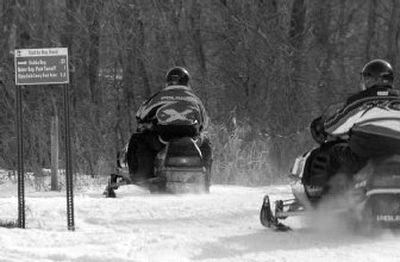Uncertain trails

MINNEAPOLIS — Here is an ironclad rule for selling snowmobiles: You need snow.
Warmer weather and thin snowfalls since the late 1990s have melted sales at Polaris Industries Inc. and Arctic Cat Inc., the only two U.S. snowmobile makers. After one more wimpy winter in a long string of them, some dealers say they’re struggling to clear out last year’s sleds, let alone sell out of this year’s. Some gave up months ago.
“When there was nothing here indicating that we were going to have a winter, by the first of October, there was a business decision. Pull the cork,” said Dick Tschida, who sells sleds in Forest Lake, a suburb of Minneapolis.
Tschida returned more than 50 Arctic Cat snowmobiles and all-terrain vehicles and is switching to boats instead. The returns cost him about $7,000, but that’s a far cry from the $250,000 loss he figured he’d take by the time he discounted them enough to sell.
A late-season storm that socked parts of the Northeast came far too late for dealers like Tschida — and for the companies.
“The industry has been down for basically a decade straight,” RBC Capital Markets analyst Edward Aaron said. This year was “probably the toughest of any of those years.”
Polaris snowmobile sales have dropped by more than half, from $373 million in 2001 to $157 million last year. Its 2006 profits dropped 22 percent to $107 million on revenue of $1.7 billion.
Arctic Cat snowmobile sales have been more stable over the past five years, but still dropped to $238 million during the year that ended March 31, 2006, down more than 5 percent from the previous year, and profits were battered by incentives to move sleds off dealer floors. Arctic Cat’s earnings of $23.7 million for the year that ended March 31, 2006, were a 16 percent drop from the previous year, even as revenue rose 6 percent to $732.8 million.
For years, Polaris and Arctic Cat seemed like twins, synonymous with Minnesota’s snowy far north. The first Polaris snowmobile was built by Edgar Hetteen and some relatives at his derrick and hoist company in the mid-1950s. He left what was by then Polaris Industries in 1960, and a year later started the company that became Arctic Cat at a time when dozens of fledgling snowmobile entrepreneurs were building snow vehicles with tracks in the back and skis in the front.
But demand for their sleds has been shrinking. Worldwide snowmobile sales peaked at 260,000 in 1997, but are expected at about 160,000 this year, according to the International Snowmobile Manufacturers Association.
The two companies have reacted in very different ways.
Polaris added Victory motorcycles and has tried to strengthen ATV sales to the military. It cut production of its 2007 snowmobiles by 40 percent to give dealers a shot at clearing out inventory. Last year snowmobiles were less than 10 percent of Polaris sales.
Arctic Cat has stuck with the snowmobiles-in-the-winter and ATVs-in-the-summer formula, and snowmobiles remain about a third of its sales. Arctic Cat cut snowmobile production far less, just 4 percent.
Arctic Cat, which didn’t make an executive available for this story, has taken some of Polaris’ snowmobile sales away. But entering new markets isn’t cheap and can take years to pay off, said Raymond James analyst Joe Hovorka.
Tschida says his days of selling snowmobiles are over. Too many people, he says, are hesitant to spend money on a toy they may not be able to use.
“They’re more apt to spend on a new aluminum boat to go fishing, because they know they can go fishing from at least the first of May until the end of September,” he said. “I can’t say that about four-wheeling or snowmobiles or any of the other winter sports.”